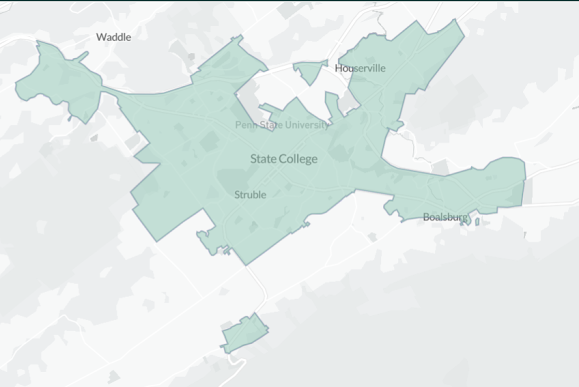Zoning Out: How Low-Density Zoning Prevents Our Community from Growing
Written by Ethan Dean
Figure 1: This figure shows the zoning boundaries of State
college borough currently. The only area for mixed use is situated right up
against the university. This area is a few square miles
Zoning plays
a pivotal role in shaping the urban fabric of our communities and is often
underestimated in its influence. Zoning has the power to change streets into a
row of houses, a dense network with cafes, erect high-rises, or maintain lawn
and parking lots. In the State College Area, zoning complexities are of
particular interest due to the multiple municipal boundaries.
Within our borough, Figure 1 depicts a significant zoning rule: it is ILLEGAL to build anything but single-family housing units on 10000 sqft parcels within residential zoned areas (this is all the orange to yellow on the map). While these regulations may seem protective, they result in extremely low-density areas that are expensive to maintain and contribute to unused space within our community.
Zoning not only defines our community but also shapes the funding of our infrastructure and public services. For instance, consider the high-rises in downtown State College. Regardless of your personal opinion, this serves as a great perspective of what density can provide to us. Tax documents reveal they make millions of dollars for the borough and each student pays about 200 dollars to the borough in school taxes, which they don’t utilize fully. They require fewer services, reduce traffic, and promote energy efficiency. You can find these documents here so you can see this real impact. This density opens up housing outside of the high-rises for community members and more to live, where they can save money and get access to these amenities. Density does not just have to be high rises; it is just the only financially viable option that is legal in our code.
Figure 2: This figure shows a new development happening
across S Buckhout St from the borough. This is a development that will house
students and is not giving any of its revenue to the borough to provide
services that we can benefit from.
There is a downside to maintaining a low-density borough; housing needs to go somewhere. It still gets built, but instead of inside the borough, new housing is added in the surrounding area, negatively impacting the community’s sustainability and affordability. Look at Toftrees, Aspen rentals, and the Haus State College (Figure 2), all right across the borough boundary. These places are built and use our amenities, costing us money for roads, parking, and more. We have no control over them and miss out on substantial revenue that could be ours if higher-density housing weren't restricted by our zoning laws. In the current zoning rewrite, the current council is recommending we make this density illegal and even harder to build than it is now.
The ongoing zoning code rewritten by the current council further tightens restrictions on density, hindering our housing market's growth. Engagement is the key, such as voting for people who represent the interests of the people, especially in the borough council. If we show up to our meetings and explain we want to legalize more types of housing and stop exclusionary zoning, change can happen. Right now, the council is doing a rewrite of the zoning code and it is very important to make it known what every person thinks and to support making our community more accessible in any way we can.
In summary, zoning's impact is profound, shaping the fabric of our communities and their financial well-being. By actively engaging with the zoning rewrite process and advocating for inclusivity, we can foster a more vibrant and accessible community for all.
Stay tuned
for more,
Ethan Dean
STHV Founderstrongtownshappyvalley@gmail.com




Comments
Post a Comment